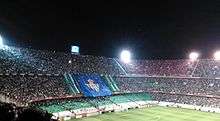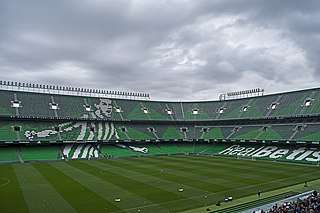Real Betis
Real Betis Balompié, S.A.D., more commonly referred to as Real Betis (pronounced [reˈal ˈβetis]) or Betis, is a Spanish professional football club based in Seville in the autonomous community of Andalusia. Founded on 12 September 1907, it plays in La Liga, having won the Segunda División in the 2014–15 season. It holds home games at Estadio Benito Villamarín in the south of the city with 60,720-seat capacity.[3]
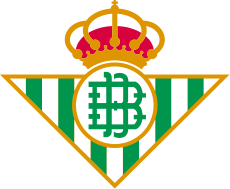 | ||
| Full name | Real Betis Balompié, S.A.D. | |
|---|---|---|
| Nickname(s) | Los Verdiblancos (The Green-and-Whites) Verderones (Big Green) Béticos Heliopolitanos (Heliopolitans) Lobos (Wolves) El Glorioso (The Glorious)[1] | |
| Short name | RBB, Betis | |
| Founded | 12 September 1907 as Sevilla Balompié | |
| Ground | Estadio Benito Villamarín | |
| Capacity | 60,720[2] | |
| President | Ángel Haro | |
| Head coach | Manuel Pellegrini | |
| League | La Liga | |
| 2019–20 | La Liga, 15th of 20 | |
| Website | Club website | |
|
| ||
| Active departments of Real Betis | ||||||||||||
|---|---|---|---|---|---|---|---|---|---|---|---|---|
|
Real Betis won the league title in 1935 and the Copa del Rey in 1977 and 2005. Given the club's tumultuous history and many relegations, its motto is ¡Viva el Betis manque (aunque) pierda! ("Long live Betis even when they lose!").[4]
History
The name "Betis" is derived from Baetis, the Roman name for the Guadalquivir river which passes through Seville and which the Roman province there was named after. Real was added in 1914 after the club received patronage from King Alfonso XIII.
Foundation

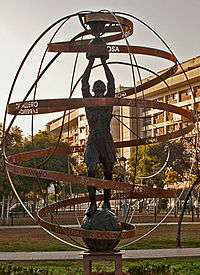
Betis' city rivals Sevilla FC were the first club in Sevilla, founded in October 1905, while a second club, Sevilla Balompié were established in September 1907. "Balompié" translates literally as "football", as opposed to the most commonly adopted anglicised version, "fútbol". Balompié was founded by students from the local Polytechnic Academy, and were in operation for two years before being officially recognised (in 1909); despite this 1907 remains the official foundation date of the club.
Following an internal split from Sevilla FC, another club was formed, Betis Football Club. In 1914, they merged with Sevilla Balompié. The club received its royal patronage in the same year, and therefore adopted the name Real Betis Balompié. Fans continued to refer to the club as Balompié and were themselves known as Los Balompedistas until the 1930s, when Betis and the adjective Béticos became common terminology when discussing the club and its followers.
Real Betis wear a green and white kit now but played in all blue jerseys and white shorts, for no other reason than the easy availability of such plain colors. But keen to take advantage of his ongoing relationships made in Scotland, Manuel Ramos Asensio – one of the founders and captain – was able to make contact with Celtic and secure the same fabric used to make the famous hoops for his own club. There is, however, no mention of Celtic or Scotland in the history of Betis on the club's official website.[5] After successfully taking receipt of the necessary material, Manuel was keen to make a statement with the team's new jerseys, by inverting the green and white lines into vertical ones to make the strips - something quite unheard of at the time in Spain. It was a move that ultimately gave birth to the Betis we see today.
1930s: promotion, championship and relegation
During the Spanish Second Republic (1931–1939), royal patronage of all organisations was nullified, and thus the club was known as Betis Balompié until after the Spanish Civil War when it would revert to the full name. The club reached the Copa del Presidente de la República final for the first time on 21 June 1931, when it lost 3–1 to Athletic Bilbao in Madrid.[6] Betis marked their 25th anniversary year by winning their first Segunda División title in 1932, finishing two points ahead of Oviedo FC,[7] thus becoming the first club from Andalusia to play in La Liga.
Under the guidance of Irish coach Patrick O'Connell on 28 April 1935 Betis won the La Liga, to date their only top division title. They topped the table by a single point over Madrid FC. A year later Betis went down to seventh. This was due to the dismantling of the championship-winning team because of the club's poor economic situation and the arrival of the Civil War, meaning that just 15 months after winning the league title only two players who won in 1935 were left: Peral and Saro. No official league was held during the Civil War between 1936 and 1939, until its resumption for the 1939–40 season and the first year back highlighted Betis' decline as exactly five years after winning the title the club was relegated.
Darkest period
Despite a brief return to the top division which lasted only one season, the club continued to decline and in 1947 the worst fears were reached when they were relegated to Tercera División. Many fans see the ten years they spent in the category as key to the "identity" and "soul" of the club. During this time, Betis earned a reputation for filling its stadium and having a massive support at away matches, known as the "Green March".
When the side returned to the second level in 1954, it gained the distinction of being the only club in Spain to have won all three major divisions' titles. Much of the credit for guiding Betis through this dark period and back into the Segunda lies with chairman Manuel Ruiz Rodríguez.
Benito Villamarín
In 1955, Manuel Ruiz Rodríguez stepped down from running the club believing he could not offer further economic growth, he was replaced by Betis most famous former president, Benito Villamarín. During his reign Betis returned to the top division in 1958–59 and finished in third place in 1964. His purchase of the Estadio Heliópolis in 1961 is seen as a key point in the history of the club – the grounds were called the Estadio Benito Villamarín until 1997. In 1965, Villamarín stepped down from his position after ten years at the helm of the club.
Just one year after Villamarín's departure, the club would again be relegated to division two, then rising and falling almost consecutively until consolidating their place in the top level in 1974–75.
First Copa del Rey Title and European Qualification
.jpg)
On 25 June 1977, Betis played Athletic Bilbao at the Vicente Calderón Stadium in the Copa del Rey final. The match finished 2–2, with Betis winning 8–7 after a staggering 21 penalties taken. This rounded off a solid season in which the club finished fifth in the league.
After that triumph, Betis competed in the European Cup Winners' Cup: after knocking out Milan 3–2 on aggregate in the first round, the side reached the quarter-finals, where they lost to Dynamo Moscow. Despite their strong performance in Europe, the team suffered league relegation.
The following year, Betis returned to the top flight and ushered in a period of "good times" for the club, with the next three seasons seeing three top-six finishes, as well as UEFA Cup qualification in 1982 and 1984.
During the summer of 1982, the Benito Villamarín hosted two matches as part of the 1982 FIFA World Cup, and also witnessed the Spain national team's famous 12–1 hammering of Malta in order to qualify for UEFA Euro 1984.
Economic crisis and Manuel Ruiz de Lopera
In 1992, Betis found itself subject to new league rules and regulations due to its restructuring as an autonomous sporting group (SAD), requiring the club to come up with 1,200 million pesetas, roughly double that of all the first and second division teams, despite being in level two at the time.
In just three months, the fans raised 400 million pesetas with then vice-president Manuel Ruiz de Lopera stepping in to provide an economic guarantee while himself becoming majority shareholder as the team narrowly avoided relegation.
On 11 September 1994 Real Betis played its 1,000th game in La Liga.
Serra Ferrer success
After another three seasons in the second division, with the club managed by Lorenzo Serra Ferrer, Betis returned to the top flight for the 1994–95 season, subsequently achieving a final third position, thus qualifying to the UEFA Cup.

In the European campaign, Betis knocked out Fenerbahçe (4–1 on aggregate) and 1. FC Kaiserslautern (4–1) before losing to defeated finalists Bordeaux (3–2). In 1997, 20 years after winning the trophy for the first time, the club returned to the final of the Copa del Rey – again held in Madrid, although this time at the Santiago Bernabéu Stadium – losing 2–3 against Barcelona after extra time.
Incidentally, Barça was the club Serra Ferrer would leave Betis for that summer, to be replaced by former player Luis Aragonés. Aragonés would only last one season with the club, leading the side to the eighth position and to the quarter-finals in the Cup Winners' Cup, where they would lose 2–5 on aggregate to eventual winners Chelsea.
Aragonés was followed by the controversial reign of Javier Clemente, who spat on a fan and implied Andalusia was "another country!". The team slipped down the table, finishing 11th and being knocked out of the UEFA Cup by Bologna in the third round. For the next couple of seasons, Betis went through numerous managers, a relegation and a promotion, after which the team finished sixth in the league with Juande Ramos at the helm.
Ramos was gone after just one season, however, being replaced by former Cup Winners' Cup-winning manager Víctor Fernández. He led the team to eighth and ninth in the league and the third round of the 2002–03 UEFA Cup, being knocked out by Auxerre (1–2 on aggregate), during his two-year reign.
For 2004, Fernández was replaced by the returning Serra Ferrer, who guided the team to the fourth position in the top flight. They also returned to the Vicente Calderón on 11 June 2005 for the Copa del Rey final, lifting the trophy for only the second time after an extra-time winner by youth graduate Dani in a 2–1 win against Osasuna.
The league finish meant Betis became the first Andalucian team to compete in the UEFA Champions League, and it reached the group stage after disposing of Monaco in the last qualifying round (3–2 on aggregate). Drawn in Group G, and in spite of a 1–0 home win against Chelsea, the club eventually finished third, being "demoted" to the UEFA Cup, where it would be ousted in the round of 16 by defeated Steaua București (0–0 away draw, 0–3 home loss).
Centenary celebrations

Betis celebrated their centenary year in 2007. The festivities included a special match against Milan, the reigning European Champions, on 9 August, with the hosts winning 1–0 thanks to a Mark González penalty early in the second half. Seven days later, the club won the Ramón de Carranza Trophy held in neighbouring Cádiz, beating Real Zaragoza on penalties in the final, having defeated Real Madrid in the semi-finals.[8]
Surrounding the celebration, it was a time of great change in terms of the playing and technical teams, with eight new signings replacing 14 departures. During the two seasons (2006–07 and 2007–08) that encompassed the centenary year, Betis had four different managers. During the latter campaign, the club was the 37th-best followed team in Europe regarding average attendances.
Segunda División
After many years of staving off relegation, Betis' 2008–09 season culminated with a 1–1 draw against Real Valladolid at home. With this outcome, the club finished 18th in the table and consequently was relegated to the second division.
On 15 June 2009, over 65,000 Beticos, including icons such as Rafael Gordillo, Del Sol, Hipólito Rincón, Julio Cardeñosa and others, joined the protest march in Sevilla with the slogan "15-J Yo Voy Betis" to let the majority owner Ruiz de Lopera know that it was time to put his 54% share of the club on the market for someone, some entity or the Betis supporters to buy those shares and remove Lopera from the day-to-day operations of the club.
Despite the protests, no upper management changes were made during the season, which would ultimately see Betis fail to gain promotion back to the top level.[9]
Lopera court action and sale
Seville judge Mercedes Alaya was investigating links between Betis and other Ruiz de Lopera-owned businesses, leading to him being formally charged with fraud. On 7 July 2010, one week before the start of preliminary court proceedings, Lopera sold 94% of the shares that he owned (51% of Betis total shares) to Bitton Sport, fronted by Luis Oliver, for the surprisingly low figure of €16 million, leaving Lopera with only minor shares; Oliver had already reportedly taken two football clubs, Cartagena and Xerez, to the brink of bankruptcy.[10]
Before the sale could be officially sanctioned, however, Ayala froze Lopera shareholdings. Left with nothing, despite putting down a €1 million deposit, Oliver hastily bought a nominal number of shares from a third party and was voted onto the board of directors by the existing members (all former cohorts of Lopera), allowing him to carry on running the club. In response to this, the judge appointed well-respected former Betis, Real Madrid and Spain national team legend Rafael Gordillo to administrate Lopera's shares to ensure Lopera was not still running the club and that decisions made were for the benefit of the club not individual board members.[11]
La Liga return
Again under Pepe Mel, Betis started 2011–12 with four wins in as many games, with Rubén Castro retaining his goal scoring form from the previous season, where he scored 27 goals. Betis finished 13th in their first season since returning to La Liga.
In the 2012–13 season, Betis finished seventh in La Liga and qualified for the 2013–14 UEFA Europa League, the first European qualification for the club since the 2005–06 Champions League. This European campaign ended in the quarter-finals after losing on penalties to local rivals Sevilla.[12] Betis were relegated from La Liga with three games still to play in the 2013–14 season,[13] but returned immediately as champions with two games to spare.[14]
Seville derby
Betis have a long-standing rivalry with city neighbours Sevilla FC.[4] The two have met 114 times in official competition, with Sevilla holding a 45% win ratio over Betis (31%).
The first match between the two clubs took place on 8 February 1915, with Sevilla winning 4–3. The match was not completed, as high tensions led an aggressive crowd to invade the pitch, forcing the referee to abandon the match.
In 1916, the first Copa Andalucía was held, this being the first official derby of the Sevilla area. Of the 17 runnings of the cup, Sevilla were victorious 14 times, to Betis' one sole conquest; this included a 22–0 routing after the latter sent their youth team, in 1918.
The first time the teams met in league, in Segunda, happened in 1928–29, with both teams winning their home matches (3–0 and 2–1). They played for the first time in the Spanish top division during the 1934–35 season, with a 0–3 home defeat for Sevilla and a 2–2 draw at Betis, with the latter winning the national championship.
On 17 January 1943, Betis lost 5–0 at Sevilla, eventually being relegated. In the first game held at the Ramón Sánchez Pizjuán Stadium, on 21 September 1958, the Verdiblancos won it 4–2.
In later years, several matches were also marred by violence, including: a security guard attacked by a Sevilla fan with a crutch (that he did not require to walk), Betis goalkeeper Toni Prats being attacked and Sevilla manager Juande Ramos being struck by a bottle of water;[15] the latter incident led to the 2007 Copa del Rey match being suspended, being played out three weeks later in Getafe with no spectators.
On 7 February 2009, Betis won 2–1 at the Pizjuán, but was eventually relegated from the top flight, while Sevilla finished in third position.
On November 9, 2019 more than 10,000 Betis fans visited the team training before the last derby in 2019.[16]
Statistics
La Liga
| Team | Wins | Home | Away |
|---|---|---|---|
| Betis | 28 | 18 | 10 |
| Sevilla | 38 | 26 | 12 |
Played 84, with 18 draws.
- Betis have scored 101 goals against their rivals, but have conceded 118.
Segunda División
| Team | Wins | Home | Away |
|---|---|---|---|
| Betis | 4 | 2 | 2 |
| Sevilla | 6 | 3 | 3 |
Played 16, with 6 draws.
Copa del Rey
| Team | Wins | Home | Away |
|---|---|---|---|
| Betis | 4 | 4 | 0 |
| Sevilla | 7 | 5 | 2 |
Played 16, with 5 draws.
History in European competitions
- Accurate as of 20 September 2018
| Competition | Played | Won | Drew | Lost | GF | GA | GD | Win% |
|---|---|---|---|---|---|---|---|---|
| UEFA Champions League | 8 | 3 | 2 | 3 | 6 | 9 | −3 | 37.50 |
| UEFA Cup Winners' Cup | 12 | 5 | 3 | 4 | 15 | 13 | +2 | 41.67 |
| UEFA Cup / UEFA Europa League | 39 | 21 | 7 | 11 | 52 | 30 | +22 | 53.85 |
| Total | 59 | 29 | 12 | 18 | 73 | 52 | +21 | 49.15 |
Source: UEFA.com
Pld = Matches played; W = Matches won; D = Matches drawn; L = Matches lost; GF = Goals for; GA = Goals against; GD = Goal Difference.
Team statistics
Season to season
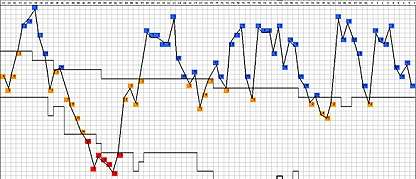
|
|
|
|
|
- 53 seasons in Primera División
- 25 seasons in Segunda División
- 7 seasons in Tercera División (as third tier)
- Participations in UEFA Champions League: 1
- Participations in UEFA Cup: 7
- Participations in UEFA Cup Winners' Cup: 2
Recent La Liga seasons
Real Betis were relegated during the 1999–2000 season from La Liga, but promoted back on their first attempt.
| Season | Pos | P | W | D | L | F | A | Pts |
|---|---|---|---|---|---|---|---|---|
| 1996–97 | 4 | 42 | 21 | 14 | 7 | 81 | 46 | 77 |
| 1997–98 | 8 | 38 | 17 | 8 | 13 | 49 | 50 | 59 |
| 1998–99 | 11 | 38 | 14 | 7 | 17 | 47 | 58 | 49 |
| 1999–00 | 18 | 38 | 11 | 9 | 18 | 33 | 56 | 42 |
| 2001–02 | 6 | 38 | 15 | 14 | 9 | 42 | 34 | 59 |
| 2002–03 | 8 | 38 | 14 | 12 | 12 | 56 | 53 | 54 |
| 2003–04 | 9 | 38 | 13 | 13 | 12 | 46 | 43 | 52 |
| 2004–05 | 4 | 38 | 16 | 14 | 8 | 62 | 50 | 62 |
| 2005–06 | 14 | 38 | 10 | 12 | 16 | 34 | 51 | 42 |
| 2006–07 | 16 | 38 | 8 | 16 | 14 | 36 | 49 | 40 |
| 2007–08 | 13 | 38 | 12 | 11 | 15 | 45 | 51 | 47 |
| 2008–09 | 18 | 38 | 10 | 12 | 16 | 51 | 58 | 42 |
| 2011–12 | 13 | 38 | 13 | 8 | 17 | 47 | 56 | 47 |
| 2012–13 | 7 | 38 | 16 | 8 | 14 | 57 | 56 | 56 |
| 2013–14 | 20 | 38 | 6 | 7 | 25 | 36 | 78 | 25 |
| 2015–16 | 10 | 38 | 10 | 11 | 14 | 31 | 48 | 45 |
| 2016–17 | 15 | 38 | 10 | 9 | 19 | 41 | 64 | 39 |
| 2017–18 | 6 | 38 | 18 | 6 | 14 | 60 | 61 | 60 |
| 2018–19 | 10 | 38 | 14 | 8 | 16 | 44 | 52 | 50 |
Players
Current squad
- As of 18 August 2020.[17]
Note: Flags indicate national team as defined under FIFA eligibility rules. Players may hold more than one non-FIFA nationality.
|
|
Returning from loan
Note: Flags indicate national team as defined under FIFA eligibility rules. Players may hold more than one non-FIFA nationality.
|
|
Reserve team
Note: Flags indicate national team as defined under FIFA eligibility rules. Players may hold more than one non-FIFA nationality.
|
|
Out on loan
Note: Flags indicate national team as defined under FIFA eligibility rules. Players may hold more than one non-FIFA nationality.
|
|
Retired numbers
26 ![]()
Player records
Most appearances
| # | Name | Matches |
|---|---|---|
| 1 | 378 | |
| 2 | 363 | |
| 3 | 343 | |
| 4 | 337 | |
| 5 | 328 | |
| 6 | 315 | |
| 7 | 305 | |
| 8 | 303 | |
| 9 | 300 | |
| 10 | 285 |
Most goals
| # | Name | Goals |
|---|---|---|
| 1 | 148 | |
| 2 | 109 | |
| 3 | 98 | |
| 4 | 93 | |
| 5 | 92 | |
| 6 | 80 | |
| 7 | 77 | |
| 8 | 59 | |
| 9 | 54 | |
| 10 | 53 | |
| 11 | 50 |
Personnel
Board of Directors
- President: Juan Carlos Ollero Pina[18]
- Vice-Presidents: José Miguel López Catalán, Ángel Haro García[18]
- Board Members: José Montoro Pizarro, Tomás Solano Franco, Ernesto Sanguino Gómez, José Maria Pagola Serra, Adrián Fernández Romero, María Victoria López Sánchez, Rafael Salas Garcia, Ramón Alarcón Rubiales, Cayetano García de la Borbolla Carrero[18]
- Ambassadors: Rafael Gordillo, Andrés Saavedra
Technical staff
- Director of Football: Eduardo Maciá[19]
- Assistant Director of Football: Alexis Trujillo
- Head Scout: Vasiliki Pappa
- Scouting: Jakob Friis-Hansen, Vlada Stosic, Carlos Vargas, Adrian Espárraga and Paulo Meneses
- Technical Analysis Department: Tino Luis Cabrera (Head) and Jaime Quesada
- Scouting U20s: Juan José Cañas (Head) and Pedro Morilla
Coaching staff
- As of 09 July 2020
- Head coach: Manuel Pellegrini
- Assistant coach: Eder Sarabia
- Fitness coach: Fran Soto
- Fitness coach: Marcos Álvarez
- Goalkeeper coach: Jon Pascua
Medical staff
- Head of Medical Services: Tomás Calero
- Physiotherapists: Fran Molano, José Manuel Pizarro, Manuel López, Manuel Alcantarilla
- Nurse: José María Montiel
Honours
Official
- La Liga
- Winners (1): 1934–35
- Copa del Rey
- Supercopa de España
- Runners-up (1): 2005
- Segunda División
- Tercera División
- Winners (1): 1953–54
- Copa de Andalucia (defunct)
- Winners (1): 1927–28
- Runners-up (13): 1919–20, 1920–21, 1922–23, 1923–24, 1924–25, 1925–26, 1926–27, 1928–29, 1929–30, 1930–31, 1931–32, 1938–39, 1939–40
Friendly
- Iberian Supercup: Runners-up 1935, 2005
- Ramón de Carranza: 1964, 1999, 2000, 2001, 2007
- Trofeo Colombino: 1968, 1983, 1995, 2009
- Guadiana Trophy: 2004
Individual
Pichichi Trophy
Zamora Trophy
- Joaquín Urquiaga (1934–35)
- Pedro Jaro (1994–95)
Coaches
| Coach | Year | Notes | |
|---|---|---|---|
| 1911–14, 1914–15 | |||
| 1914, 1916 | Also first president | ||
| 1917 | |||
| 1918 | |||
| 1918 | |||
| 1920 | |||
| 1922, 1939–40, 1943–46, 1949–52, 1965 | |||
| 1923 | |||
| 1924 | |||
| 1925 | |||
| 1927–30 | First year of league competition (1929) | ||
| 1930–32 | Copa del Rey runner-up 1931 Segunda champion 1932 | ||
| 1932–36, 1940–42, 1946–47 | La Liga champion 1935 | ||
| 1942–43 | |||
| 1942–43, 1953–55 | Tercera champion, 1954 | ||
| 1944–45 | |||
| 1946–47, 1948–49 | |||
| 1947–48 | |||
| 1952–53 | |||
| 1955, 1960, 1968–69 | |||
| 1955–57, 1967–68 | |||
| 1957 | |||
| 1957–59, 1967, 1969–72 | Segunda champion 1958 and 1971 | ||
| 1959 | |||
| 1959–60 | |||
| 1960–63, 1968–69 | |||
| 1963, 1965, 1966 | |||
| 1963–64 | |||
| 1964–65 | |||
| 1965–66 | |||
| 1966–67 | |||
| 1967–68 | |||
| 1969–70 | |||
| 1971–72 | |||
| 1972–76 | Segunda champion 1974 | ||
| 1976–78, 1981–82 | Copa del Rey winner, 1977 | ||
| 1978–79 | |||
| 1979–80 | |||
| 1979–81, 1984–86 | |||
| 1981, July 28, 1997 – June 30, 1998 | |||
| 1982, 1988–89 | |||
| 1982 | |||
| 1982–83 | |||
| 1983–85 | |||
| 1985–87, 2001 | |||
| 1987–88 | |||
| 1988 | |||
| 1988–89 | |||
| 1989 | |||
| 1990 | |||
| 1990–91 | |||
| 1991, 1993 | |||
| 1991–92 | |||
| 1992 | |||
| 1992–93 | |||
| 1993–94 | |||
| 1994–97, July 1, 2004 – June 8, 2006 | Copa del Rey winner 2005 Qualified for 2005-2006 Champions League | ||
| 1998 | |||
| Aug 26, 1998 – Oct 26, 1998 | |||
| Oct 27, 1998 – June 30, 1999 | |||
| 1999–00 | |||
| Jan 2, 2000 – June 30, 2001 | |||
| Feb 1, 2000 – May 31, 2000 | |||
| July 1, 2000 – March 19, 2001 | |||
| July 1, 2001 – May 16, 2002 | |||
| July 1, 2002 – June 30, 2004, Jan 26, 2010 – July 12, 2010 | |||
| July 1, 2006 – Dec 22, 2006 | |||
| Dec 27, 2006 – June 10, 2007 | |||
| July 14, 2007 – Dec 2, 2007 | |||
| Dec 3, 2007 – April 7, 2009 | |||
| April 7, 2009 – June 30, 2009 | |||
| July 1, 2009 – Jan 25, 2010 | |||
| July 12, 2010 – Dec 2, 2013, Dec 19, 2014 – Jan 11, 2016 | Segunda champion, 2011 and 2015 | ||
| Dec 2, 2013 – Jan 19, 2014 | |||
| Jan 19, 2014 – May 19, 2014 | |||
| Jun 16, 2014 – Nov 25, 2014 | |||
| Nov 25, 2014 – Dec 19, 2014, Jan 11, 2016 – May 9, 2016 | |||
| May 9, 2016 – Nov 12, 2016 | |||
| Nov 12, 2016 – May 9, 2017 | |||
| May 9, 2017 – May 26, 2017 | |||
| May 26, 2017 – May 19, 2019 | |||
| June 6, 2019 – June 21, 2020 | |||
| 2020- |
Presidents
|
|
Records
Club records
- Best La Liga position: Champions (1934–35)
- Worst La Liga position: 20th (1990–91, 2013–14)
- Biggest home win: Betis 7–0 Zaragoza (1958–59)
- Biggest away win: Cádiz 0–5 Betis (1977–78)
- Biggest home defeat: Betis 0–5 Real Madrid (1960–61, 2013–14), Betis 0–5 Osasuna (2006–07) , Betis 0–5 Barcelona (2017–18)
- Biggest away defeat: Athletic Bilbao 9–1 Betis (1932–33)
- Biggest comeback for: Betis – Barcelona: 0–2 to 3–2 (2007–08[20])
- Biggest comeback against: Betis – Espanyol: 2–0 to 2–5 (1999–00)
Player records
- Most appearances:

- Most official appearances:

- Most appearances in La Liga:

- Most appearances in Copa del Rey:

- Most appearances in European competitions:

- Top goalscorer (La Liga):

- Top goalscorer (overall): Rubén Castro – 148
- Top goalscorer (European competitions):

- Most red cards:

- First to play for Spain:

- Most capped for Spain:

- Spanish internationals: 27
Stadium
With a 60,720-seat capacity, the Estadio Benito Villamarín is the home ground of Real Betis. It was named Estadio Manuel Ruiz de Lopera during the 2000s (decade) after the club's owner, who decided to build a new stadium over the old one.
Despite much planning, the stadium's renovation plans were constantly postponed, and half of it remained unchanged. On 27 October 2010, it returned to its first denomination after a decision by the club's associates.[25]
Colours
Evolution
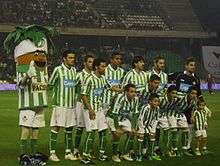
In its initial years, Sevilla Balompié dressed in blue shirts with white shorts, which represented the infantry at the time. From late 1911, the team had adopted the shirts of Celtic,[26] at that time vertical stripes of green and white, that were brought over from Glasgow by Manuel Asensio Ramos, who had studied in Scotland as a child. On 28 February 2017, on the 37th Día de Andalucía, Real Betis wore Celtic-inspired hoops against Málaga CF.[27]
When the team became Real Betis Balompié in 1914, various kits were used, including: yellow and black stripes; green T-shirts and a reversion to the blue top and white shorts uniform. By the end of the 1920s, Betis was once again sporting green and white stripes, around this time the Assembly of Ronda (1918) saw the Andalusian region formally adopt these colours, not being known how much the two are linked.
Since then, this remained Betis' shirt, despite several versions (including wider stripes).
References
- "Archived copy". Archived from the original on 2012-11-01. Retrieved 2013-03-18.CS1 maint: archived copy as title (link)
- "New features for Benito Villamarín Stadium". www.realbetisbalompie.es. Archived from the original on 2017-08-04. Retrieved 2017-06-29.
- Jones, Rich (2019-02-09). "We ranked the top 10 stadium in La Liga - with a surprise No.1". mirror. Retrieved 2020-01-25.
- "Real Betis, 100 years of passion". FIFA.com. 18 January 2007. Retrieved 26 April 2011.
- "La historia - Real Betis Balompié". www.realbetisbalompie.es.
- "Spain - Cup 1931". rsssf.com. Retrieved 8 June 2017.
- "Spain, Final Tables 1928-1939". rsssf.com. Retrieved 8 June 2017.
- "Todos los partidos de la pretemporada 2007–08" [All the matches in the 2007–08 preseason] (in Spanish). Real Betis. 17 August 2007. Archived from the original on 30 December 2009. Retrieved 26 April 2011.
- "Lopera sigue mudo y ultras lo amenazan: 'Vende o muere'" [Lopera still says nothing and is threatened by ultras: 'Sell or die'] (in Spanish). El Mundo. 3 June 2009. Retrieved 26 April 2011.
- "Oliver: "Ni los nazis hacían lo que hace esta loca"" [Oliver: "Not even nazis did what this crazy woman does"] (in Spanish). Marca. 27 October 2010. Retrieved 26 April 2011.
- La venta se cierra en 16 millones a pagar en 5 años (Sold for 16 millions to be paid in 5 years); El Desmarque, 7 July 2010 (in Spanish)
- "Spot-on Sevilla get the better of Betis". UEFA. 20 March 2014. Retrieved 27 April 2014.
- "Ronaldo brace sends Real second, Betis relegated". FIFA. 26 April 2014. Retrieved 27 April 2014.
- "Real Betis win promotion to Primera Division after Alcorcon victory". Sky Sports. 25 May 2015. Retrieved 26 May 2015.
- "This was no isolated incident". The Guardian. 1 March 2007. Retrieved 26 April 2011.
- "Más de 10.000 béticos arropan a su equipo en el último entrenamiento antes del derbi". Marca.com (in Spanish). 2019-11-09. Retrieved 2019-11-25.
- "PLANTILLA" (in Spanish). realbetisbalompie.es. Retrieved 25 October 2018.
- "Real Betis Balompié - Board of Directors". www.realbetisbalompie.es. Retrieved 8 June 2017.
- "Real Betis Balompié - Latest News". www.realbetisbalompie.es. Archived from the original on 18 August 2016. Retrieved 8 June 2017.
- Siesta azulgrana (Azulgrana nap); Marca, 29 March 2008 (in Spanish)
- José Ramón Esnaola; Manquepierda, 25 July 2018 (in Spanish)
- José Ramón Esnaola; Manquepierda, 25 July 2018 (in Spanish)
- José Ramón Esnaola; Manquepierda, 25 July 2018 (in Spanish)
- José Ramón Esnaola; Manquepierda, 25 July 2018 (in Spanish)
- "De Ruiz de Lopera a Benito Villamarín: el estadio sin nombre" [From Ruiz de Lopera to Benito Villamarín: the nameless ground] (in Spanish). Marca. 27 October 2010. Retrieved 27 April 2011.
- "LOS COLORES DEL REAL BETIS BALOMPIÉ". www.lapalanganamecanica.com. Retrieved 8 June 2017.
- Online, Record Sport (16 February 2017). "Celtic tribute kit unveiled by Real Betis for Andalusia Day fixture". Retrieved 8 June 2017.
External links
| Wikimedia Commons has media related to Real Betis. |
- Official website (in Spanish and English)
- Real Betis at La Liga (in English and Spanish)
- Real Betis at UEFA (in English and Spanish)
